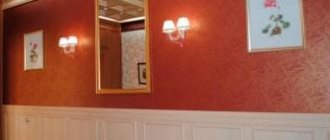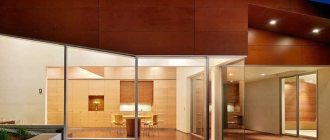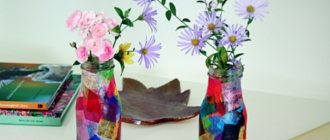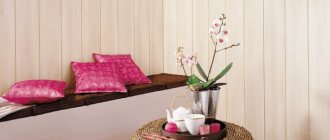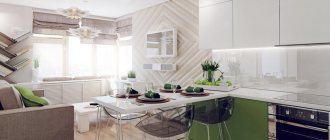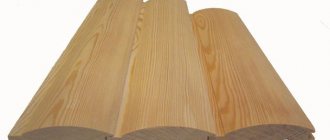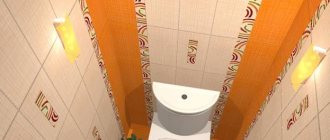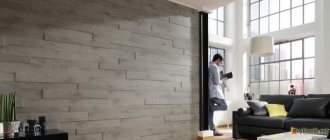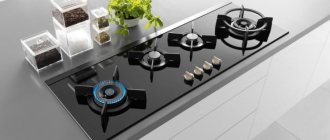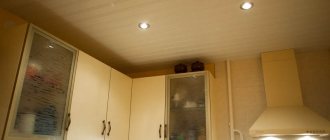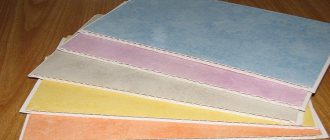Pros and cons of paneling
The mentioned materials are conventionally divided into wall and ceiling. Wall ones are used exclusively for walls, while universal ones are suitable for finishing walls and ceilings.
There are a number of positive aspects to using decorative panels:
- There is no need to dismantle the old coating or apply numerous layers of plaster to level the surfaces.
- The installation technique is simple. The products are attached to the frame or directly to the wall; a builder without much experience will be able to glue the finishing fragments.
- Caring for the coating does not require long time and effort.
- The panels are well insulated from extraneous noise, and when they are attached to the frame, the voids are additionally filled with soundproofing material, enhancing the effect.
- Installation of the panels allows you to hide electrical communications under them and make a neat connection of pipes to the boiler and water heater.
- If the neighbors do not turn on the tap and you are flooded, the panels will not deform, but will dry out after a while.
- You can make repairs at any time of the year, without producing mountains of construction waste, bypassing the finishing stage.
As for the cons:
- Some types of panels are not strong enough and can be deformed.
- MDF and chipboard do not tolerate prolonged exposure to moisture. Mold may develop under plastic panels; prolonged UV irradiation can lead to discoloration.
- Not every type of panel can withstand overheating; installing them in close proximity to the stove is not recommended.
- When installing, you must take into account the weight of the building material in order to choose a reliable fastening method. Do not chase low prices; as a rule, they indicate low quality products.
Features of plastic wall panels for the kitchen
Plastic plates have appeared quite a long time ago, almost since the invention of the material itself. Modern models are characterized by increased strength, thanks to an updated chemical composition based on polyvinyl chloride, but at the same time they are significantly inferior to other materials due to low strength and heat resistance.
The material from which plastic slatted kitchen wall panels are made is polyvinyl chloride.
The main advantage of this type is its low cost, the widest selection of products, as well as the ease of installation of the structure. Thanks to this material, you can solve a lot of problems in the kitchen and other rooms. Positive characteristics include their smoothness and density. PVC slats do not absorb moisture and do not allow steam to pass through, therefore they do not accumulate odors and do not contribute to the development of fungi and bacteria. The slats are easy to clean using any detergent.
Plastic panels for the bathroom: use, types and sizes (read more)
The main properties of PVC plates are their lightness and flexibility. They produce kitchen wall panels made of plastic in different sizes. The strips can be up to 50 cm wide and up to 3 m long. They can be installed on the ceiling, walls and as an apron. The exception is the area near the stove or hob, since when exposed to high temperatures, the plastic is deformed. In addition, plastic is easily subjected to mechanical stress, scratches remain on it, and white plates turn yellow over time.
Despite the low cost, PVC material is durable.
Types and types of panels for the kitchen
The finishing material is shaped like:
| Rack and pinion | It is presented in slats from the narrowest of 12 cm to the widest of 50 cm. The slats are attached to each other thanks to the presence of grooved joints, as well as to the sheathing. |
| Tiled | It has the shape of a square with sides from 30 to 60 cm. Usually used instead of ceramic tiles. |
| Listov | The most aesthetic and convenient material to work with. Its dimensions from 1.5 to 3 m2 allow you to cover a large area of the wall at once. Installed on wooden, metal sheathing or using the adhesive method. |
Plastic panels
Most popular. The consumer is attracted by a large selection of colors, the ability to fit into any budget. At the same time an economical and decorative option. Thanks to the protective coating, the products do not absorb odors, which is important for those areas where evaporation is high.
The product is essentially an MDF sheet, with a PVC coating on the outside, which is why in its finished form it has water-repellent properties and resists temperature fluctuations. At the same time, their low cost and durability make plastic panels very attractive for customers on a limited budget.
But they are not suitable for every surface. Their thermal stability is limited.
PVC panels realistically imitate natural wood, marble, leather, aluminum, chrome, and are varied in texture: they look like untreated or painted boards, textured plaster. Slatted white panels are organic in Provence and country style. Bright gloss looks good in modern interiors. Sheet material can have a uniform, smooth surface or its top layer consists of fragments that resemble ceramic tiles.
Solid wood panels
To give the kitchen a sophisticated look, use natural wood panels. Pine, ash, and cherry perfectly withstand elevated temperatures and humidity. Beech or oak are more prestigious options. Wood stores heat well, insulates sounds, and can be combined with other materials.
The wax in the composition gives durability to the products. Special components prevent the smell of food from penetrating into the material. Some factories resort to a technique where more accessible species are used in the inner layers of the coating, and more valuable ones in the outer ones. Sheets with a top veneer of expensive species are attached without visible seams over large areas, creating a monolithic surface.
When installing solid wood panels in the kitchen, it acquires special colors and naturalness, chic, and status. The texture of the wood creates the effect of comfort and luxury.
Decorative panels made of MDF and chipboard
A budget option for finishing the kitchen is chipboard or MDF wall panels. Chipboard is less suitable for a kitchen backsplash. Temperature changes and humid fumes have a bad effect on it. The pressed wood shavings used in production swell when exposed to water. To ensure that the coating does not lose its original appearance, it will require systematic treatment with special impregnations. Laminated panels protect the internal structure from getting wet and the surface layer from scratches. When cutting, you must ensure that the sections are processed with special tapes.
MDF panels are strong, durable, and resistant to temperature and humidity. Laminated products most often replicate the color and texture of natural wood. The design of most kitchen furniture models uses acrylic film coating.
Proper selection of the texture and color of the apron will help to combine the tabletop and part of the wall located between the upper and lower tier of the furniture set into a single composition.
Bamboo panels
Demand is observed not only for panels made of mahogany and walnut; exotic bamboo is gaining popularity. This is a natural, eco-friendly material with a unique texture. It is not afraid of moisture, direct sunlight, or temperature fluctuations.
Bamboo panels are made using hand-made mats that are impregnated with acrylic-based glue. Decorative panels are obtained by hot pressing and subsequent drying of these blanks. The finished product looks lightweight, but is strong, flexible, and durable. No further processing is required.
Bamboo slabs have color options, fine or coarse weave, and come in single or double ply. Installation is simple. They are cut with scissors or a hacksaw, secured with glue, liquid nails, or a stapler. Always work with gloves.
Warm country, elegant minimalism, and ethnic exoticism will not be complete without bamboo products. The natural greenish tint can be covered with any other using paint or tinting varnish.
Gypsum panels
A kitchen decorated with gypsum panels looks original and unusual. With the help of 3D panels, the space of a room can be narrowed or expanded, demarcated, or highlighted in some corner. The aesthetic effect of such finishing is enhanced by lighting. The interior of the kitchen will look monumental. They imitate covering walls with wood and stone, creating the illusion of volume and high relief.
The advantage of gypsum panels is ease of installation, environmental safety, products are inexpensive, and do not deform. Such a disadvantage as the lack of moisture resistance is eliminated by treating the surface with a special composition.
Over time, dirt and grime can accumulate on the textured surface. This will create certain difficulties during cleaning, but at the same time it will give the drawing greater expressiveness.
Glass panels
The main advantage of glass panels is the endless number of design options. Even the smallest kitchen, decorated with glass, will become more spacious and brighter.
Wall panels are made individually for a specific room from three-layer glass. The topmost hardened heavy-duty coating is almost impossible to damage. Next comes the decorative layer, followed by the base. How decor is used:
- coloring;
- matting;
- various images on the mirror;
- photo printing;
- 3D pictures.
Glass coating is expensive, which is justified by its excellent performance properties. The material is hygienic, has absolute moisture resistance and heat resistance. The mounted glass panels located behind the sink or stove are unique in each case, will not change color, will not absorb odors, and can be washed with almost any household chemicals.
Wall decorative panels for aprons: features and benefits
Due to the fact that the wall panels meet all the requirements of a practical apron, this type of finishing has become very popular. In addition, it has a wide range of advantages that put it first in terms of practicality, efficiency and aesthetics.
On a note! Panels in the kitchen are used not only as a wall covering in the apron area. With their help, you can cover uneven ceilings and walls, hide communications and other flaws.
A wide range of wall panels allows you to choose the right option for finishing your kitchen.
Experts include the following as the main positive characteristics of wall panels:
- Easy and quick installation. The surface does not require special preparation for placing the material. The process itself does not require special tools or certain practical skills.
- The versatility of the material lies in the fact that they perfectly absorb sound and do not allow heat to pass through.
- Masking with panels allows you to hide wires and cables. At the same time, they do not have to be immersed in the wall and covered with plaster, which must be done when using tiles.
- Practicality of wall panels. Kitchens with such an apron do not require special care and frequent washing; special detergents are also not required.
- Economical. Installing panels is much cheaper than tiling or decorative painting.
- A wide range of materials allows you to choose the right option based on practical and other requirements.
- Aesthetics. Wall panels for kitchen interior decoration will help make the overall design beautiful and unique.
- High heat and moisture resistance is ensured by a special coating on the panels that repels water and does not deform under the influence of steam.
Wall panels for finishing the apron will make the kitchen unique and original.
Features and installation tips
The choice of fastening method takes into account the characteristics of the material. For example, wood is much heavier than PVC and requires careful screwing to the sheathing. If the wall is fairly flat, you can simply stick plastic on it. Wood boards are secured using a system of grooves. Under glass - special profiles are made where it is inserted like into a frame.
The installation method also depends on the properties of the surface. Both ceramic tiles and PVC can be laid well on a perfectly flat surface. Where the walls are far from perfect, it is better to install lathing. On the working wall, the slats are placed only around the perimeter.
For PVC and MDF tiles, assembly with a groove system is provided. The glass is fixed either in special profiles or with screws to the guides. Each manufacturer recommends its own solutions.
The appearance of some materials should not be disturbed with fasteners, since damage to the protective laminated layer will disrupt the external aesthetics and lead to gradual delamination.
MDF kitchen panels: characteristics and advantages
MDF products can be an excellent alternative to plastic panels. Their peculiarity lies in the standard size. The dimensions of the plates from the manufacturer are: 244X60X4cm. MDF panels can be painted, laminated and covered with veneer.
In the kitchen, MDF wall panels are most often used to finish the apron, but often also for partial or complete wall cladding.
Medium-density fiberboard, abbreviated MDF, is produced by hot pressing wood fibers. During the manufacturing process, no adhesives that release toxins are used. The particles in the middle of the material are connected to each other due to resins that are released when heated. Thanks to this feature, MDF boards are considered harmless, and therefore can be installed in both the working and dining areas, without danger to health.
Other advantages of MDF wall panels for the kitchen are the following characteristics:
- environmental friendliness of the material;
- low cost;
- ease of processing;
- moisture resistance;
- impact resistance;
- ease of care;
- variety of models;
- possibility of photo printing;
- ease of installation.
The possibility of applying photo printing on slabs made of fibreboards allows you to get a beautiful and stylish interior using wall panels for the kitchen. MDF aprons are most often produced with abstract drawings, table themes and still lifes.
Kitchen aprons made of MDF are often laminated and have standard sizes.
MDF panels also have disadvantages:
- slabs cannot be installed above a stove because they cannot withstand high temperatures;
- the panels do not have a natural appearance;
- photo printing looks worse than on natural wood or stone.
Installation of MDF boards occurs by fastening them to a special sheathing. This installation allows you to disguise electrical wiring or ventilation systems.
Rules for caring for panels
In order for the kitchen decoration to retain its original appearance for a long time, it needs careful care. This especially applies to wood coverings. Such surfaces do not tolerate abrasive detergents, they are not cleaned with solvents or washing powders, and hard brushes are not used. Veneered and varnished panels are washed with a soft cloth soaked in a specially designed product.
Solid wood is periodically treated with wax-containing compounds. Contaminants are removed using a soap solution and recommended detergents with surfactants.
Plastic will also require careful handling and careful selection of means for mechanical cleaning.
Intense exposure to water is contraindicated for any type of panel, as it can cause unwanted cracks, swelling, stains and streaks. Delicate care with professional products without ammonia and alcohol will ensure an impeccable appearance of the products.
Rules of care
Caring for decorative kitchen panels is not difficult. After installation, they must be wiped with a damp cloth using gentle detergents.
Aspects of choosing cookware for an induction cooker
Design of a combined kitchen-living room: zoning and styles (110 photos)
How to decorate walls inside a house - the best ideas, materials and examples of use with photos
They will easily remove construction dust and adhesive residues. Never use abrasive cleaners, as they can damage the surface of the material.
The choice of finishing materials is an entirely individual decision, depending on the preferences of the owners and the family budget. If you have chosen decorative panels, you have provided yourself with a strong and durable coating.

